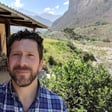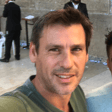Become a Creator today!Start creating today - Share your story with the world!
Start for free
00:00:00
00:00:01

Siddharth Sinha
We talk about going from tech companies in the US/England to the family cement business in India to creating a generative AI agency.
Recommended
Transcript
Introduction to Siddharth Sinha
00:00:01
joewaltman
Alright, so we've got Siddharth Sinha. Siddharth, thanks so much for making the time.
00:00:05
Siddharth
and Great to be here, Joe. Good to talk to you.
00:00:08
joewaltman
So first question, ah refresh your memory.
Early Career and Education
00:00:11
joewaltman
What were you doing before in CIAD and what have you been up to for the last 20 years?
00:00:14
Siddharth
Oh, that's a short question. ah mr So actually, I left India when I was 18. And I went to college at Cornell. I did my undergrad at Cornell and then worked in the US for five years. I was working for a company called Lutron.
00:00:31
Siddharth
Lutron is the world's largest supplier of lighting control systems, building management systems, energy management systems, those kinds of platforms. I started off in product development, did quite some interesting stuff, designed and implemented ah RF radios, radio frequency ah controls for for lighting this was before the days of Bluetooth.
00:00:55
Siddharth
So I've got a couple of them.
00:00:55
joewaltman
Yeah, what when would this have been?
00:00:57
joewaltman
And and where were you?
00:00:58
Siddharth
I was just south of Allentown in in Pennsylvania at that time. And this was in started in 97 and I was there for about five years there.
00:01:09
joewaltman
Okay.
00:01:11
Siddharth
And and just some very cool stuff.
00:01:13
Siddharth
for
00:01:13
joewaltman
What brought you from what are you from India to Pennsylvania?
00:01:17
Siddharth
ah So I did a pit stop at at Cornell. I did my undergrad at Cornell.
00:01:20
joewaltman
Okay, okay.
00:01:22
Siddharth
And this is my first job. um i I sort of gravitated towards this, but I found the company very interesting. It was started by a company a guy called by Joel Spira, and the company was still private, and they were about $400 million dollars in sales, and was a very interesting person, very customer-focused, very tech product development-focused. So it was a very engineering-driven company.
00:01:49
Siddharth
So that sort of appealed to me. When I was looking at my first job, I wanted to get into product development. I was into software, into hardware design. So it was a good place to be. So did some interesting stuff with them. Got a couple of patents as well. Designed their first radio frequency protocols, radio transceivers that they still use, actually, um and theyre out in the field all over the world.
Returning to India
00:02:15
Siddharth
I got married just ah end of 2001. Both me and my wife were very keen in moving back to India over time. And NCI seemed to be a good midway hop to to get back to India. So I joined the program in 2002.
00:02:35
Siddharth
Beyond that, I worked for a year in the UK, in London, for the same company. Actually, they wanted they wanted me back, at this time, more on a product marketing role, so was helping them.
00:02:47
joewaltman
This is this after it's yet.
00:02:48
Siddharth
This is after NCIAD. there
00:02:50
joewaltman
Did they pay for your MBA or did you you just go back on your own?
00:02:53
Siddharth
No, you know and just I just went back on their ah on my own.
00:02:54
joewaltman
Okay.
00:02:56
Siddharth
They had offered to pay me a pay for my MBA at Wharton, but I was fairly keen on doing an MBA outside.
00:03:02
joewaltman
Really? Those bastards. so that they they They wouldn't pay for a ah crappy European MBA, but they would pay for a, ah u okay.
00:03:04
Siddharth
data so
00:03:06
Siddharth
the Exactly. So so was said then I worked for them for in in London, helped them design their retail strategy and and in the UK and Europe on selling into retail. So that was interesting. Then got a break to work at one of the first product startups in India. This is in Bangalore before Bangalore was the hot startup scene. This was back in 2004.
00:03:36
Siddharth
So I moved back to India at that time, worked for the startup that was to that was started by a few ex Texas Instruments guys and designing software and IP, intellectual property algorithms for encoding and decoding of software.
00:03:56
Siddharth
and and
00:03:57
joewaltman
No, hold on, hold on. You're in the US post undergrad or during undergrad. you You then went to France. You then did a little bit of time in England. Did you have like some burning desire to get back to India or is it just just sort of what ...
00:04:10
Siddharth
So we did wanted to go want to go back to India and both Nishika and my wife and I and had just gotten married just before we started it. I started at INSEAD. We were very keen that we we moved back to India.
00:04:22
Siddharth
We have our kids in India. That was something that both of us were very keen on doing. So this was INSEAD and UK were sort of pit stops on the way back.
00:04:30
joewaltman
Yeah, yeah.
00:04:31
Siddharth
So that was there.
00:04:32
joewaltman
Uh-huh. And what it must have it must have been in, you know, 05, 06 when you were you had moved back to India shortly after NCI had ended.
00:04:39
Siddharth
This was just at the end of 2004. I think in December 2004 is when we moved back to India.
00:04:43
joewaltman
Okay. Oh, wow. Okay.
00:04:47
Siddharth
So it was still early days in Bangalore, very different city than it is today.
00:04:51
joewaltman
Yeah, yeah. there there's there's what's What's the term they use for for people like you who go who go off and study and work and then come back? That was probably before that trend really had picked up, right?
00:04:59
Siddharth
Yes, yes. So these are, I don't know what they call them actually. returnees, I guess.
00:05:04
joewaltman
but non-resident it this It's almost like a condescending term or or a patronizing term.
00:05:05
Siddharth
not So are a couple of terms that they use for, they're actually official terms for for Indians that are living abroad.
00:05:08
joewaltman
but
00:05:15
Siddharth
there there's ah There's something called a PIO, which is a person of Indian origin.
00:05:19
Siddharth
And there's an OCI status, which is an overseas citizen of India. So that's how they classify sort of people that have left and sort of spent time.
00:05:20
joewaltman
Okay.
00:05:28
Siddharth
at
00:05:28
joewaltman
Cool.
00:05:28
joewaltman
Okay. So we're all four.
00:05:28
Siddharth
project
00:05:29
joewaltman
You're back in India. What's going on?
00:05:31
Siddharth
So there I was working for this ah for the startup, again, a very heavy technology focus. I did that for about a year and a half, and then did a complete change in my career. My family was in business in India for a long time. I'm a fourth-generation entrepreneur.
Challenges in the Family Business
00:05:51
Siddharth
for to Four generations of entrepreneurs in my family. I got a call from my dad saying that you know we had a cement manufacturing operations in in a state called Bihar in India, that there was a turnaround situation.
00:06:05
Siddharth
They wanted somebody from the family to actually go in and and and take up that that effort. I knew nothing about cement manufacturing or cement operations, and none of that. And this was as brick and mortar as it gets from from being in software and and technology.
00:06:21
Siddharth
ah But I took that challenge. It was a very steep learning curve, ah but I moved with my
00:06:27
joewaltman
and you had never worked in this business, had had your siblings or other family members worked in this business or you?
00:06:31
Siddharth
ah So i had I had a cousin that had worked there. but that i mean I had never actually done this. So I moved into, actually spent ds a couple of years at the facility.
00:06:43
Siddharth
And this was a really remote, I mean, this is in one of the poorest districts in India.
00:06:47
joewaltman
Don't take this question the wrong way, but why why'd they choose you because you were this crazy inside guy who went off and learned about business or was that were were you the only one available?
00:06:54
Siddharth
the So maybe I was just crazy enough. I have no idea. and So go out you know the my i had just ah my first door of my first born to my daughter was just born at the end of 2005 and she was about six months old when we decided to do this change. Moved with her and my wife to to this facility which was ah this is one of the poorest districts in India.
00:07:17
Siddharth
and was at that time ah affected by what was called the Naxal Movement. It was a marvelous movement, a marvelous insurgency in some districts in India and Eastern India. So the facility was actually located in in one of these locations. So I went in there within the first three or four months, had to fire the entire plant management, got new people in there. We had a little bit of capital to to sort of redo the plant, but we've literally tried to bootstrap a cement operations at that point.
00:07:47
Siddharth
us
00:07:47
joewaltman
this is like This is a case study.
00:07:48
joewaltman
What what year would this have been?
00:07:48
Siddharth
the This was in 2006, end of 2006.
00:07:54
joewaltman
Oh, wow. Oh, wow.
00:07:54
Siddharth
And so this was an interesting story of the of the company itself. the The company had been around, my great grandfather had started it and started cement operations in 1946. This was the first FDI investment in, so foreign investment in cement in India. So there's a company called Wholesim, which is a ah Swiss conglomerate. They had invested with us into this facility.
00:08:19
Siddharth
It was the first foreign investment into any facility in in India. So it was actually a very a relatively modern plant, well set up, but it ran into a lot of regulatory issues.
00:08:31
Siddharth
It was set up in a location that was ah outright hostile to private private endeavor, private enterprise. So it actually ran into a lot of political issues.
00:08:40
joewaltman
because Because of the Mallet stuff you're you're referring to. wow
00:08:43
Siddharth
And just the political environment was was was extremely negative. So yeah know I went in there, had to get my hands dirty very quickly with the with getting new people into the facility. Did all sorts of things because this was a time where you know there was a lot of, there was a big boom in cement plant know setups. So everything was, I mean, any spare parts, any new equipment that you wanted to order was two years out. We had two years lead times into any equipment that we wanted to buy.
00:09:14
Siddharth
So, according to reverse engineering of parts, doing some black magic metallurgy with Chinese equipment manufacturers, as I spent a lot of time in China roaming around, bearing manufacturers, machinery manufacturers trying to reverse engineer, build a lot of the spare parts, but we had to keep the facility running. That's one of the things that that we had to do.
00:09:37
Siddharth
but managed to finally to get get the whole thing turned around. In a couple of years, we declared the first net profits that the company had made for over 20 years. Got a big change and in the whole setup and in the whole environment that was there. But it was a crazy time. While I was there, you know we had a kidnapping from our mines.
00:10:02
Siddharth
which we had to extract the person out. We had a couple of attempts at, so we used to store, it was an open cost mine. So we had explosives stored in magazines.
00:10:13
Siddharth
There were a couple of attacks on the magazine to get there the explosives. So we'll go through all of that.
00:10:20
joewaltman
to in order in order to to to do damage to you or just to get the explosive to do damage to other people.
00:10:23
Siddharth
not at there so Typically, so the the the whole insurgency, if you look at the the history, i mean they were very it didn't really care about private enterprise. They were really against the state.
00:10:34
Siddharth
They would actually target the state. so the Private enterprise weren't really targeted except for these kinds of incidents in some sense.
00:10:37
joewaltman
okay
00:10:41
joewaltman
yeah like i was i was and I don't mean to be too James Bondy and 14-year-old little boy curiosity, but like what what kind of stuff did you have to do to for your own you know physical safety?
00:10:42
Siddharth
um
00:10:51
joewaltman
Did you did you have you know security, blahh blah, blah, blah?
00:10:52
Siddharth
so the So the first thing I did actually was actually get rid of my personal boarding guard there. So that's ah that's one of the things that, I mean, just just to buy the trust of the people that I was working with. there that's i mean You had to but embed yourself into the into the whole and endeavor.
00:11:09
Siddharth
and it's it's sort of it's it's its ah you And you look at things in in hindsight and seem almost funny, because we had an incident, for example, where we had the paramilitary forces contacted me, the labs in the facility, they wanted to do a raid inside our plant.
00:11:24
Siddharth
because they had traced a mobile phone call out to within the facility. And they did that. And it turned out that ah you know one of one of our employees was staying in the residences within the premises, had a brother with him who was portter i was an insurgent.
00:11:42
Siddharth
And he had an AK-47, a couple of grenades stored in the in the facility. So they had to come. over They came in, they did a whole bit.
00:11:48
joewaltman
so So the brother was like the Maoist guy and the government was contacting you to, oh my lord, wow, that's spicy.
00:11:51
Siddharth
Yeah. good yeah ah but but All sorts of you know interesting you know things that happened in that time.
00:12:00
joewaltman
Yeah.
00:12:00
Siddharth
but it actually ah In sense, going through that whole exercise and and you know working with the team to get this this whole thing turned around and and doing all of that was actually incredibly satisfying.
00:12:15
Siddharth
incredibly
00:12:17
joewaltman
yeah
00:12:19
Siddharth
in know It's something that I don't think I could do that. I mean, have those same experiences in any other way. I just had to take that risk and that sort of jump off the deep end to be able to do all of that. So I did all of that. So I got the whole facility turned around, did fairly good for a couple of years, repaired some of the extremely scary balance sheet that we had. So I got some good numbers in there.
00:12:50
Siddharth
But then, you know as they say, history repeats itself according to a whole so whole bunch of regulatory issues beyond that. Those are generally too boring to go into into depth, but we got into some environmental issues with the with our mines, so we weren't able to actually to run the army in mines for a while.
00:13:11
Siddharth
So, I mean, the end of the story is is is fairly fairly sad in some sense because we had to sell the facility in bankruptcy about three years after that because of the the when you would run the facility for for about about three years.
00:13:21
joewaltman
Mm.
00:13:26
Siddharth
I sold the company to one of the larger cement ah chains in India. All said and done, did reasonably well so because we had 1200 employees, ensured that they all got paid, got all their retirement savings per se, were saved or secured and all of that. So all in all, had a fairly good exit in the circumstances that were there.
00:13:50
Siddharth
but that that was It was an interesting experience, that did that whole exercise of actually getting going back, getting your hands ah more than dirty to actually but all of this ah pull all of this through.
Entrepreneurial Ventures
00:14:04
Siddharth
so it's a
00:14:04
joewaltman
Yeah, amazing.
00:14:04
joewaltman
Amazing. And so what what year would this have been when when it when you finally close that chapter?
00:14:07
Siddharth
So we sold ah in 2018, sold the company in 2018.
00:14:11
joewaltman
Oh, wow. Well, but so you spent, what what is this, 10-ish years?
00:14:15
Siddharth
I spent 12 years almost, 12 years.
00:14:17
joewaltman
Uh-huh. Wow.
00:14:18
Siddharth
yeah so It took us took us about two and a half years to get the facility going.
00:14:18
joewaltman
Wow.
00:14:21
Siddharth
We had a good run for about five, for six years.
00:14:24
joewaltman
Uh-huh.
00:14:25
Siddharth
And then the last three or four years were a bit bit of a struggle.
00:14:28
joewaltman
Yeah.
00:14:29
Siddharth
But all in all, I think it's it's it's a life's worth of experiences in in that time. So that was good.
00:14:39
Siddharth
So i mean ah beyond that, i mean just to you know really hammer home the the point that I'm really a masochist. I'm now doing a ah startup with my wife.
00:14:52
Siddharth
So I'm actually working at, so I have a a tech startup that's actually, that released seed-drowned funding for a couple of years back. So this is so my wife.
00:15:01
joewaltman
This was the next the next the next thing after the cement company shut down or it was sold.
00:15:04
Siddharth
The next time. So I spent about a year trying to figure out what I wanted to do. My wife was running a company that was working with e-commerce retailers, large studios, helping them create all the imagery that they need for for online selling. So it was mostly a services-oriented organization at that point, doing a lot of Photoshop work, graphic design work.
00:15:29
Siddharth
speak so She was working with the co-founder of hers, so I joined them in... late 2019 and started Resma. Resma is the name of the startup in 2020. Essentially looking at productizing the entire as content creation value chain in some sense, doing before generative AI using a lot of 3D rendering, a lot of AI to actually do image enhancements. We also developed a photography app.
00:15:59
Siddharth
that you can pick up and and do your own product photography rather than hiring photographers or taking products for the studios. So build out that entire platform and then sort of using generative AI now to actually doing, you know, adding a lot of creative imagery, text content, ad content, all of that for for brands for online selling.
00:16:21
joewaltman
Very interesting. yeah you've been you're You're on the front lines of this AI i change.
00:16:27
Siddharth
Yeah?
00:16:28
joewaltman
um When did you you know see that coming? and when did you Because presumably you had to turn all these human beings who are doing this photoshopping and whatnot into you know i script creators or or prompt creators.
00:16:37
Siddharth
Yeah. so yes So we started using foundational models very early. So this was one 21.
00:16:49
Siddharth
So we started using foundational models to to to replace the, yeah, yeah.
00:16:50
joewaltman
ah Well, way before the generative AI stuff was popularized, yeah.
00:16:54
Siddharth
Yes. So at that time, were doing you know ah replacing a lot of the work that people were doing on Photoshop, like background removals, exposure corrections, lighting corrections, automating all of those processes. And then we started doing creative imagery using 3D rendering, real-time 3D rendering. But that sort of got all replaced with the generative AI.
00:17:16
Siddharth
So that piece is now entirely generative AI driven. So with that, we started work on early 2023, just as when the diffusion models were becoming more popular.
00:17:27
joewaltman
Yeah. yeah
00:17:30
joewaltman
well Wow. and How are you finding it? because the the but I assume there's some paranoia in your mind of, wow, this is going to be so easy that our clients won't even need somebody like us to to do this.
00:17:42
joewaltman
ah How are you sort of trying to stay ahead of that?
00:17:42
Siddharth
it's interesting so It's interesting. So the the way we look at the at the businesses is in two layers. right So there is the the content ah creation layer, which essentially is ah you know you want to you want to showcase your bag with a model carrying it in a certain environment and getting the output.
00:18:00
Siddharth
the way you want it, the the way your brand looks, and the way your brand feels. So there is that whole content layer, generation layer, which we feel is important to get right, but it's also something that will get commoditized over time. but So that's ah that's that's one layer. The second layer, which we which you feel that there is real real moat to and real meat to, is basically an intelligence layer that sits on top of the content layer, which is essentially advising you as to what kind of content should you be creating.
00:18:30
Siddharth
and what is working in your in the marketplaces and the social media and and pulling in intelligence from your competitors' social media feeds to to what's working in different adjacent markets. And bringing all of that together and essentially prompting you or prompting the the content creation layer to actually give you options as to look. here's Here are four posts that you should be pushing out the next week for your brand. And these are the products that you should be showcasing given you know the wild trends that are that are moving around.
00:19:00
Siddharth
So that's something that that we feel, I mean, you can't do the second one before the first.
00:19:06
joewaltman
Yeah.
00:19:06
Siddharth
and
00:19:07
joewaltman
but where you I assume you weren't really pushing the second one before generative AI was out. You were saying, hey, well just you tell us what to make and we'll make these things for you.
00:19:15
Siddharth
yes
00:19:16
joewaltman
Now you're saying you need you need us to tell you what kinds of imagery or whatever whatever to make.
00:19:16
Siddharth
yes
00:19:19
Siddharth
what yes
00:19:21
joewaltman
is your
00:19:21
Siddharth
exactly
00:19:22
joewaltman
is How is the, let's let's call it commercial relationship with your client's change as a result of that that shift? Or are you still basically a consultancy and charging?
00:19:32
Siddharth
Yeah, so basically, so on the content creation side, it was very much a usage model. So were depending on where how many images you were building or pushing through the system is is how much you were getting charged. ah The intelligence layer is is much more of a you know a ah fixed subscription model where you were essentially buy into or get access to ah the intelligence. and When you connect your your brand, your your website, your social media channels, you connect ah you tell us your competitors and we essentially create a marketing distancing map for you and then look at trends and and what's happening in that in that space too ah to sort of give you what what kind of posts or content you should be creating.
00:20:06
joewaltman
Yeah.
00:20:14
joewaltman
That's super cool. and that's that's that's a ah This is a tough, quick-moving space. Being able to sort of pivot the the business to reflect that is is impressive.
00:20:25
Siddharth
Yeah, it's ah it's it's something, and ah the the good or bad about it is that it's changing for everybody, right? And everybody's sort of scrambling to to figure out what ah how they stay relevant, how they stay you know how they bring value to their customers in this in this market.
00:20:44
joewaltman
For sure, for sure. Are your clients mostly Indian based or are you or you doing a worldwide set now?
00:20:48
Siddharth
No, actually, only about 15% of our revenue is in India. Rest of it comes from the US and Western Europe.
00:20:56
joewaltman
Cool, cool, very cool. Well, that's a good segue for ah for for the final question. Is there anything that i we as the community can do to help you and vice versa? what what What might you be able to do to help help ah us?
00:21:10
Siddharth
I'll take the second one first. so i mean i I'm always open to anybody who's looking at doing any business in India, any information they want, any help that they need. I still have some relationships with government reportees as well, so I can help out in that.
00:21:27
Siddharth
My sister, I mean, one of the things that I happen to find some time to do the in 2011-12 was start an eco-lodge with my sister. So I set up and built a an eco-lodge near one of the game parks in India.
00:21:42
Siddharth
So the Indian jungles aren't as as famous as the African ones for for wildlife sporting, but they're actually very very very interesting.
00:21:43
joewaltman
Cool.
00:21:49
Siddharth
A lot of biodiversity, a lot of interesting animal spotting. Tigers are great to to spot in the wild. So she runs now a wildlife resort in central India, and she's actually now opening up to more locations. So if anybody from the NCI committee wants to come see tigers in India, I'm more than happy to connect you and and get her to host you for for a few days.
Future Prospects and Funding
00:22:15
Siddharth
oh In terms of what help I can need, I mean, as a startup, we're always looking at both from a fundraise perspective and as well as well as market market or customer introductions. Anybody who's doing fashion, fashion, accessory brands, home decor brands, we can help with with content with with some of the market intelligence that we're building out. That'd be great. We're also doing a ah five million pre-series A round now.
00:22:44
Siddharth
That's something that if anybody has any connections with the VC world.
00:22:46
joewaltman
Oh, nice. Yeah. Let's get some funds raised. what what what kind of What's the minimum check you're you're you're accepting?
00:22:52
Siddharth
I haven't really talked to that one, but you know we can there we can look at it.
00:22:55
joewaltman
All right.
00:22:59
Siddharth
We should have a lead investor in place within the next three or four weeks, so we'll put all of that together after that.
00:23:07
joewaltman
as as As per my normal terms, if any if any funding closes through this conversation, I'll expect a very modest commission for for for myself.
00:23:14
Siddharth
Sure, sure. I only play in stock.
00:23:16
joewaltman
ah
00:23:16
Siddharth
I only play in stock.
00:23:20
joewaltman
Hey, thank you so, so much for for the time. Really nice getting up. You got a really, really great story.
00:23:26
Siddharth
Yeah. We're talking to you, though.
00:23:29
joewaltman
Take care.



















